A Review on Natural Biodegradation of Plastics

| International Journal of Polymer and Textile Engineering |
| © 2022 by SSRG - IJPTE Journal |
| Volume 9 Issue 1 |
| Year of Publication : 2022 |
| Authors : Siddhartha Sankar Saha, Md. Ibrahim H. Mondal |
How to Cite?
Siddhartha Sankar Saha, Md. Ibrahim H. Mondal, "A Review on Natural Biodegradation of Plastics," SSRG International Journal of Polymer and Textile Engineering, vol. 9, no. 1, pp. 1-5, 2022. Crossref, https://doi.org/10.14445/23942592/IJPTE-V9I1P101
Abstract:
Pollution due to plastic wastes has led to a severe increasing the demand for plastic materials globally. Micro-plastics (less than 5 mm) can enter the food chain and cause several health impacts. There are some conventional methods for the reduction of plastic pollution; heat treatment, chemical treatment, incineration, recycling, landfill, etc., which are not sufficient. Besides, biodegradation of plastic materials by micro-organisms and light (photochemical biodegradation) is very slow. Some plastics are very sensitive to Nature and decomposed by micro-organisms very quickly, but some are very stable. This present review discusses the biodegradation of plastic materials in Nature (soil, water).
Keywords:
Biodegradation, plastics, pollution, micro-organism, health impact.
References:
[1] Plastics Europe. The Compelling Facts About Plastics: An Analysis of Plastics Production, Demand and Recovery for 2006 in Europe. (2008). Available From:
Https://Www.Plasticseurope.Org/Application/Files/2815/1689/9283/2006compelling_Fact_Pubjan2008.Pdf.
[2] M. Garside., Plastics Industry - Statistics & Facts, Https://Www.Statista.Com/ Topics/5266/Plastics-Industry/, 2020. (Accessed 29 June 2020).
[3] T. Maria & R. Ieva., Baseline Report on Plastic Waste, (2020).
[4] S. Hossain, A. Rahman, M. A. Chowdhury & S. K. Mohonta., Plastic Pollution in Bangladesh: A Review on Current Status Emphasizing the Impacts on the Environment And Public Health, Environmental Engineering Research, 26(6) (2021) 200535. Doi: https://Doi.Org/10.4491/Eer.2020.535
[5] R. Hannah & R Max., Plastic Pollution [Internet], (2020) [Cited 1 September 2020]. Available From: https://Ourworldindata.Org/Plastic-Pollution.
[6] EPA, Plastics: Material-Specific Data. Https://Www.Epa.Gov/Facts-And-Figuresabout-Materials-Waste-And-Recycling/Plastics-Material-Specific-Data, (2019). (Accessed 29 June 2020).
[7] Chen, & N. Yan, A Brief Overview of Renewable Plastics, Materials Today, Sustainability, 7-8 (2020) 100031. Https://Doi.Org/10.1016/J.Mtsust.2019.100031
[8] F. Alshehrei., Biodegradation of Synthetic and Natural Plastic by Micro-Organisms, J. Appl. Environ. Microbiol. 5(1) (2017) 8-19. Doi: 10.12691/Jaem-5-1-2.
[9] Y. Orhan, J. Hrenović & H. Büyükgüngör., Biodegradation of Plastic Compost Bags Under Controlled Soil Conditions, Acta Chimica Slovenica 51(3) (2004) 579-588
[10] Y. Tokiwa & T. Suzuki., Degradation of Poly (Ethylene Glycol) Adipate by A Fungus, Journal of Fermentation Technology, 52 (1974) 393-398.
[11] Y. Tokiwa & T. Suzuki, T., Hydrolysis of Polyesters by Lipases, Nature, 270 (5632) (1977b) 76-78. Doi: 10.1038/270076a0.
[12] Y. Tokiwa, T. Ando, & T. Suzuki., Degradation of Polycaprolactone By A Fungus, Journal of Fermentation Technology, 54 (1976) 603-608.
[13] J. G. Sanchez, A. Tsuchii, Y. Tokiwa., Degradation Of Polycaprolactone at 50 °C by a Thermotolerant Aspergillus Sp., Biotechnology Letters, 22 (10) (2000) 849-853, 2000. DOI: 10.1023/A:1005603112688
[14] A. Tsuchii, & T. Suzuki,&Fukuoka, Microbial Degradation Of Polyethylene Oligomers, Rep. Ferment. Res. Inst., 55 (1980) 35-40, 1980.
[15] D. Bikiaris, & C. Panayiotou., LDPE/Starch Blends Compatibilized with PE-G-MA Copolymers, Journal of Applied Polymer Science, 70(8) (1998) 1503-1521. Https://Doi.Org/10.1002/(SICI)1097-4628(19981121)70:8<1503::AID-APP9>3.0.CO;2-%23
[16] K. Aneta, Urbanek, W. Rymowicz & A.M. Mirończuk., Degradation of Plastics and Plastic-Degrading Bacteria in Cold Marine Habitats, Applied Microbiology & Biotechnology, 102(18) (2018) 7669–7678. Doi: 10.1007/S00253-018-9195-Y
[17] S. Tanasupawat, T. Takehana, S. Yoshida, K. Hiraga & K. Oda., Ideonella Sakaiensis Sp. Nov. Isolated from A Microbial Consortium That Degrades Poly (Ethylene Terephthalate), International Journal if Systematic and Evolutionary Microbiology, 66(8) (2016) 2813–2818. https://Doi.Org/10.1099/Ijsem.0.001058
[18] S. Oberbeckmann, A.M. Osborn & M.B. Duhaime ., Microbes on A Bottle: Substrate, Season and Geography Influence Community Composition of Microbes Colonizing Marine Plastic Debris, PLOS ONE 11(8) E0159289 (2016). Doi: 10.1371/Journal.Pone.0159289.
[19] S. Oberbeckmann & M. Labrenz., Marine Microbial Assemblages on Microplastics: Diversity, Adaptation, and Role in Degradation, Annual Review of Marine Science, 12 (2020) 209–232.
[20] J.P. Harrison, M. Sapp & A.M. Osborn., Interactions between Micro-Organisms and Marine Microplastics: A Call for Research, Marine Technology Society, 45(2) (2011) 12-20.
[21] G. Caruso., Microbial Colonization in Marine Environments: Overview of Current Knowledge and Emerging Research Topics, Journal of Marine Science and Engineering, 8(2) (2020) 78. https://Doi.Org/10.3390/Jmse8020078

 10.14445/23942592/IJPTE-V9I1P101
10.14445/23942592/IJPTE-V9I1P101